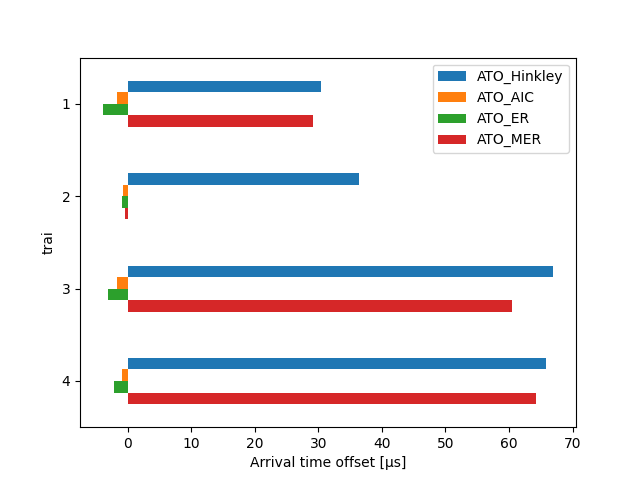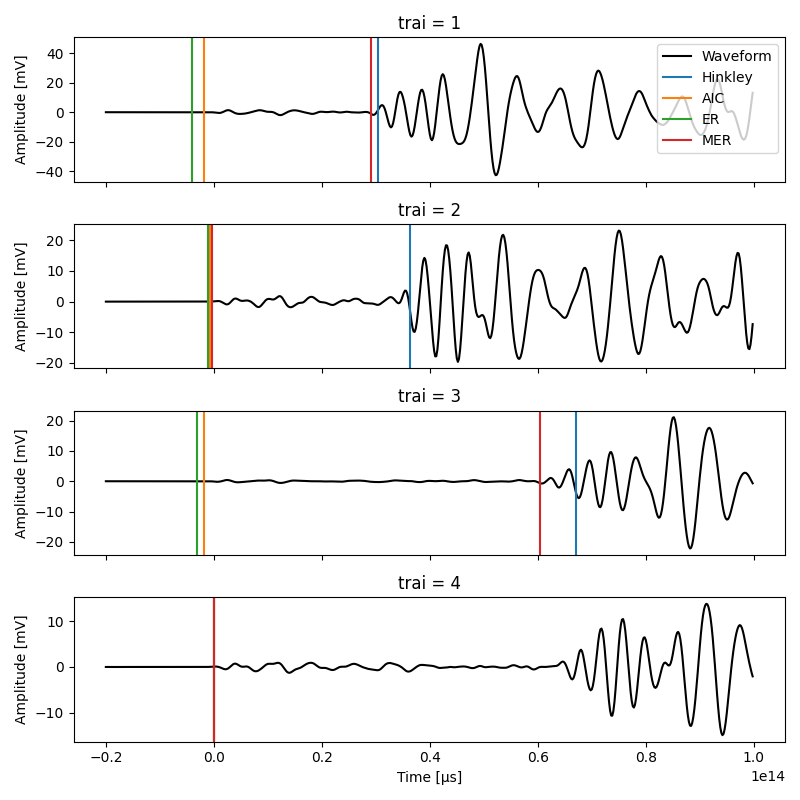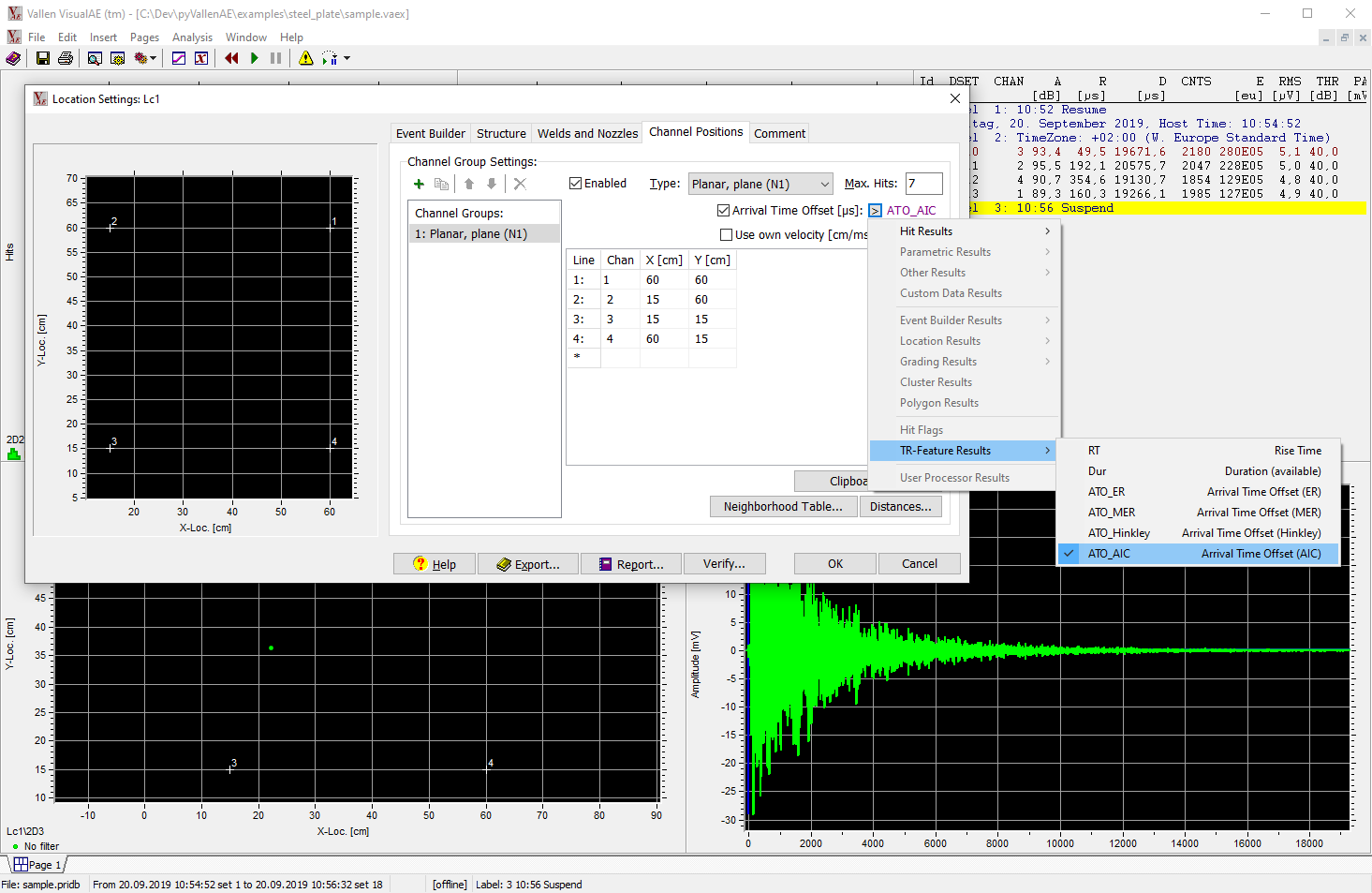Note
Go to the end to download the full example code
Timepicker batch processing
Following examples shows how to stream transient data row by row, compute timepicker results and save the results to a feature database (trfdb).
from pathlib import Path
from shutil import copyfile
from tempfile import gettempdir
import matplotlib.pyplot as plt
import pandas as pd
import vallenae as vae
HERE = Path(__file__).parent if "__file__" in locals() else Path.cwd()
TRADB = HERE / "steel_plate" / "sample_plain.tradb"
TRFDB = HERE / "steel_plate" / "sample.trfdb"
TRFDB_TMP = Path(gettempdir()) / "sample.trfdb"
Open tradb (readonly) and trfdb (readwrite)
Read current trfdb
print(trfdb.read())
Trf: 0%| | 0/4 [00:00<?, ?it/s]
Trf: 100%|██████████| 4/4 [00:00<00:00, 27369.03it/s]
FFT_CoG FFT_FoM PA ... CTP FI FR
trai ...
1 147.705078 134.277344 46.483864 ... 11 222.672058 110.182449
2 144.042969 139.160156 59.450512 ... 35 182.291672 98.019981
3 155.029297 164.794922 33.995209 ... 55 155.191879 95.493233
4 159.912109 139.160156 29.114828 ... 29 181.023727 101.906227
[4 rows x 8 columns]
Compute arrival time offsets with different timepickers
To improve localisation, time of arrival estimates using the first threshold crossing can be refined with timepickers. Therefore, arrival time offsets between the first threshold crossings and the timepicker results are computed.
def dt_from_timepicker(timepicker_func, tra: vae.io.TraRecord):
# Index of the first threshold crossing is equal to the pretrigger samples
index_ref = tra.pretrigger
# Only analyse signal until peak amplitude
index_peak = vae.features.peak_amplitude_index(tra.data)
data = tra.data[:index_peak]
# Get timepicker result
_, index_timepicker = timepicker_func(data)
# Compute offset in µs
return (index_timepicker - index_ref) * 1e6 / tra.samplerate
Transient data is streamed from the database row by row using vallenae.io.TraDatabase.iread.
Only one transient data set is loaded into memory at a time.
That makes the streaming interface ideal for batch processing.
The timepicker results are saved to the trfdb using vallenae.io.TrfDatabase.write.
for tra in tradb.iread():
# Calculate arrival time offsets with different timepickers
feature_set = vae.io.FeatureRecord(
trai=tra.trai,
features={
"ATO_Hinkley": dt_from_timepicker(vae.timepicker.hinkley, tra),
"ATO_AIC": dt_from_timepicker(vae.timepicker.aic, tra),
"ATO_ER": dt_from_timepicker(vae.timepicker.energy_ratio, tra),
"ATO_MER": dt_from_timepicker(vae.timepicker.modified_energy_ratio, tra),
}
)
# Save results to trfdb
trfdb.write(feature_set)
Read results from trfdb
print(trfdb.read().filter(regex="ATO"))
Trf: 0%| | 0/4 [00:00<?, ?it/s]
Trf: 100%|██████████| 4/4 [00:00<00:00, 80273.76it/s]
ATO_Hinkley ATO_AIC ATO_ER ATO_MER
trai
1 30.4 -1.8 -4.0 29.2
2 36.4 -0.8 -1.0 -0.4
3 67.0 -1.8 -3.2 60.4
4 65.8 -1.0 -2.2 64.2
Plot results
ax = trfdb.read()[["ATO_Hinkley", "ATO_AIC", "ATO_ER", "ATO_MER"]].plot.barh()
ax.invert_yaxis()
ax.set_xlabel("Arrival time offset [µs]")
plt.show()

Trf: 0%| | 0/4 [00:00<?, ?it/s]
Trf: 100%|██████████| 4/4 [00:00<00:00, 87838.83it/s]
Plot waveforms and arrival times
_, axes = plt.subplots(4, 1, tight_layout=True, figsize=(8, 8))
for row, ax in zip(trfdb.read().itertuples(), axes):
trai = row.Index
# read waveform from tradb
y, t = tradb.read_wave(trai)
# plot waveform
ax.plot(t[400:1000] * 1e6, y[400:1000] * 1e3, "k") # crop and convert to µs/mV
ax.set_title(f"trai = {trai}")
ax.set_xlabel("Time [µs]")
ax.set_ylabel("Amplitude [mV]")
ax.label_outer()
# plot arrival time offsets
ax.axvline(row.ATO_Hinkley, color="C0")
ax.axvline(row.ATO_AIC, color="C1")
ax.axvline(row.ATO_ER, color="C2")
ax.axvline(row.ATO_MER, color="C3")
axes[0].legend(["Waveform", "Hinkley", "AIC", "ER", "MER"])
plt.show()

Trf: 0%| | 0/4 [00:00<?, ?it/s]
Trf: 100%|██████████| 4/4 [00:00<00:00, 68200.07it/s]
Use results in VisualAE
The computed arrival time offsets can be directly used in VisualAE.
We only need to specify the unit. VisualAE requires them to be in µs.
Units and other column-related meta data is saved in the trf_fieldinfo table.
Field infos can be retrieved with vallenae.io.TrfDatabase.fieldinfo:
print(trfdb.fieldinfo())
{'FFT_CoG': {'SetTypes': 2, 'Unit': '[kHz]', 'LongName': 'F(C.o.Gravity)', 'Description': 'Center of gravity of spectrum', 'ShortName': None, 'FormatStr': None}, 'FFT_FoM': {'SetTypes': 2, 'Unit': '[kHz]', 'LongName': 'F(max. Amp.)', 'Description': 'Frequency of maximum of spectrum', 'ShortName': None, 'FormatStr': None}, 'PA': {'SetTypes': 8, 'Unit': '[mV]', 'LongName': 'Peak Amplitude', 'Description': None, 'ShortName': None, 'FormatStr': None}, 'RT': {'SetTypes': 8, 'Unit': '[µs]', 'LongName': 'Rise Time', 'Description': None, 'ShortName': None, 'FormatStr': None}, 'Dur': {'SetTypes': 8, 'Unit': '[µs]', 'LongName': 'Duration (available)', 'Description': None, 'ShortName': None, 'FormatStr': None}, 'CTP': {'SetTypes': 8, 'Unit': None, 'LongName': 'Cnts to peak', 'Description': None, 'ShortName': None, 'FormatStr': '#'}, 'FI': {'SetTypes': 8, 'Unit': '[kHz]', 'LongName': 'Initiation Freq.', 'Description': None, 'ShortName': None, 'FormatStr': None}, 'FR': {'SetTypes': 8, 'Unit': '[kHz]', 'LongName': 'Reverberation Freq.', 'Description': None, 'ShortName': None, 'FormatStr': None}}
Show results as table:
print(pd.DataFrame(trfdb.fieldinfo()))
FFT_CoG ... FR
SetTypes 2 ... 8
Unit [kHz] ... [kHz]
LongName F(C.o.Gravity) ... Reverberation Freq.
Description Center of gravity of spectrum ... None
ShortName None ... None
FormatStr None ... None
[6 rows x 8 columns]
Write units to trfdb
Field infos can be written with vallenae.io.TrfDatabase.write_fieldinfo:
trfdb.write_fieldinfo("ATO_Hinkley", {"Unit": "[µs]", "LongName": "Arrival Time Offset (Hinkley)"})
trfdb.write_fieldinfo("ATO_AIC", {"Unit": "[µs]", "LongName": "Arrival Time Offset (AIC)"})
trfdb.write_fieldinfo("ATO_ER", {"Unit": "[µs]", "LongName": "Arrival Time Offset (ER)"})
trfdb.write_fieldinfo("ATO_MER", {"Unit": "[µs]", "LongName": "Arrival Time Offset (MER)"})
print(pd.DataFrame(trfdb.fieldinfo()).filter(regex="ATO"))
ATO_Hinkley ... ATO_MER
SetTypes None ... None
Unit [µs] ... [µs]
LongName Arrival Time Offset (Hinkley) ... Arrival Time Offset (MER)
Description None ... None
ShortName None ... None
FormatStr None ... None
[6 rows x 4 columns]
Load results in VisualAE
Time arrival offsets can be specified in the settings of Location Processors - Channel Positions - Arrival Time Offset. (Make sure to rename the generated trfdb to match the filename of the pridb.)

Total running time of the script: (0 minutes 0.834 seconds)